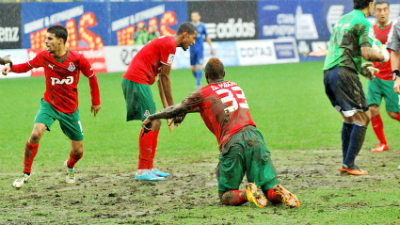On Wednesday night, Russian champions CSKA hosted their first home game of the Champions League campaign, with Czech side Viktoria Plzen the visitors. Except, of course, that they didn’t. Zenit did, their Petrovsky pitch being used for the second European night in succession after the owners’ goalless draw against Austria Wien.
In many ways, it was a reasonable outcome for the Muscovites – initial proposals had seen Krasnodar mooted as a venue, several hundred miles further south. With their own temporary home at Arena Khimki deemed to be unplayable, the army club were instead forced north into the home of their title rivals for a game on the biggest stage. This weekend, they will host Dinamo at Lokomotiv’s reserve stadium, such is the state of their usual playing surface.
If that were not sufficient embarrassment for a country midway through preparations for hosting the World Cup, it was announced earlier on the same day that Spartak, the self-appointed national club, will play their next league game at ‘home’ in Ekaterinburg, a city straddling the Eurasian border and a stadium a full day’s train journey from the home support. They too have suffered from pitch problems, Luzhniki’s closure for renovation forcing them to share Cherkizovo with Lokomotiv – a less than perfect solution.

Even Cherkizovo has felt the effects of over-use.
With Luzhniki out of action, Cherkizovo and Arena Khimki unable to cope with the double demand now being placed upon them, and Torpedo’s crumbling Eduard Streltsov home suffering from security concerns as well as limited capacity and issues of age, it is clear that Moscow has a stadium problem.
It is worth pointing out that it is not just Moscow that has its problems. Rubin moved away from their old home in the winter due to conditions underfoot before the opening of the new Kazan Arena, while in the Russian Far East, SKA-Khabarovsk have had to abandon their Lenin Stadium after torrential flooding rendered the ground useless.
Nevertheless, it is a major cause for concern for the nation, not least because of the huge distances involved. A move from Luzhniki to Cherkizovo or Khimki might be manageable, St Petersburg is possible at a push, but for the average fan to realistically expect to reach Krasnodar or Ekaterinburg is laughable. Russian football has rarely placed the fans first, but the present situation in the capital makes a mockery of the need to increase attendances ahead of the World Cup.

Tsentralnyi Stadion, Ekaterinburg – the new ‘home’ of Spartak.
On balance, some clubs have made great strides forward in bringing the game back to the supporters. To combat the difficult winters, Ural have used an indoor arena for matches – something Dinamo and other clubs are looking into. In Krasnodar, away fans are let in for free if they promise not to use foul language.
But the fact remains that, with the budget for 2018 rising all the time – it is almost certain to be the most expensive World Cup ever (until Qatar) – little has been invested in making Russia’s, and particularly Moscow’s stadiums places for fans to enjoy their team.
Farcical use of Luzhniki at times last season – CSKA vs third-tier Tyumen in the cup, for example – has meant that authorities did not identify alternatives for Spartak and CSKA’s necessary moves. With four Moscow clubs in the top flight and Torpedo in the second tier, it is simply not possible for fans to be shuttled from one ground to the other.
The Moscow region has plenty of alternatives, none of which are ideal but many of which could be commandeered for one-off emergencies – Saturn’s old stomping ground in Ramenskoye and Vityaz’s home in Podolsk spring to mind. If St Petersburg and Krasnodar are considered viable alternatives, surely the likes of Yaroslavl and Ryazan would prove easier to reach for travelling home fans?
What the current situation has shown is that Dinamo, Spartak and CSKA’s eternal quests for new homes cannot come soon enough. Luzhniki is already covered in drama, the Otkritia Arena has drawn criticism for its sponsorship, while Dinamo’s VTB Arena looks the least controversial of the three. The never-ending saga of Zenit’s new ground to the north is a warning however, that particularly in Russia, these things take time.
Attendances across the city may not be great – only Loko draw crowds comparable to a top flight European side – but the fact that so many of the nation’s top sides play in unsuitable grounds with ploughed fields as pitches is not conducive to boosting the numbers. While the improvements made in some of the country’s lesser-known regions is laudable, the message to the Russian Football Union is clear – sort out the mess in the capital and provide facilities which can be used all year round, or risk alienating a huge slice of their fanbase.

